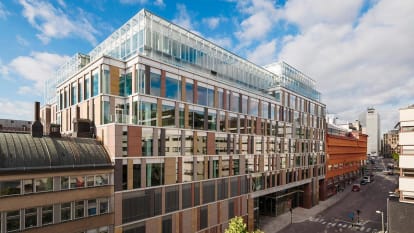Mästerhuset - A modern office building with a focus on sustainability
Mästerhuset has one of Stockholm’s most attractive locations and, with 11 storeys and a leasable area of approximately 30,900, has room to accommodate 3,000 tenants. The property has received environmental certification in accordance with LEED.
A modern office building
There is a restaurant on the entrance level, while the remaining floors consist of office premises. Users are only a few minutes’ walk away from a number of underground railway stations, including the main hub T-Centralen.
The façade consists of glass and four different types of natural stone, and the scale of colours is drawn from the façades of the buildings in Gamla Stan – Stockholm’s picturesque Old Town. The centre of the building contains a large atrium, which has a glass ceiling for maximum daylight. The top floors have large terraces which boast views of central Stockholm.
The elevators have been built to exacting standards to ensure that the waiting time of the tenants is minimised and working days are made more efficient. For maximum flexibility, the office floors have only two fixed cores, consisting of elevator halls and toilet groups – the remaining areas are open. The cavity flooring in the storeys containing offices enables the tenants to easily alter the layout to meet changing needs, as electrical connections are installed under the floor.
A sustainable office building
For both the client and NCC, sustainability thinking has permeated the project and great emphasis was placed on the building receiving a LEED certification of the highest rating: Platinum. LEED looks at the entire chain, examining the local environment, water usage, energy usage, materials and the indoor climate, both during and after the construction period. The building has strict energy requirements while, at the same time, high demands have been set for the indoor environment. In order to meet these objectives, all the project planners collaborated closely to find the optimal solutions.
Complex challenges
The land given over to Mästerhuset had previously been used for three older office buildings. An electrical substation is connected to Mästerhuset, and this provides the central areas of Stockholm with power. The demolition of the original buildings was challenging in several ways, but one of these was the demolition of prefabricated elements while taking into consideration the substation, which has very high demands on vibration levels. The central location also placed extremely high requirements for well-functioning logistics.
